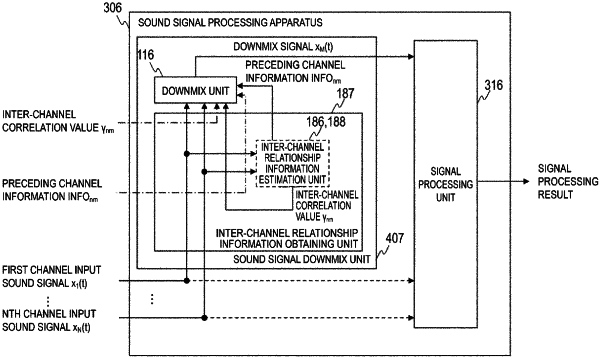| CPC G10L 19/008 (2013.01) [G10L 19/24 (2013.01); H04S 1/007 (2013.01); H04S 7/30 (2013.01); H04S 2400/03 (2013.01)] | 8 Claims |

|
1. A sound signal downmix method of obtaining a downmix signal that is a monaural sound signal from input sound signals of N channels, N being an integer of three or greater, the sound signal downmix method comprising:
an inter-channel relationship information obtaining step of obtaining an inter-channel correlation value and preceding channel information of every pair of two channels included in the N channels, the inter-channel correlation value being a value indicating a degree of a correlation between input sound signals of the two channels, the preceding channel information being information indicating which of the input sound signals of the two channels is preceding; and
a downmix step of obtaining the downmix signal by weighting and adding the input sound signals of the N channels, the input sound signal of each channel being weighted based on the inter-channel correlation value and the preceding channel information such that the larger a correlation with an input sound signal of a preceding channel that precedes the channel, the smaller a weight, whereas the larger a correlation with an input sound signal of a succeeding channel that succeeds the channel, the larger the weight, wherein
the inter-channel relationship information obtaining step includes
a channel sorting step of sequentially performing sorting in an order from a first channel such that an adjacent channel is a channel with a most similar input sound signal among remaining channels, and obtaining a first sorted input sound signal to an Nth sorted input sound signal that are signals after the sorting of the N channels, and first original channel information to Nth original channel information of the N channels for the sorted input sound signals, the first original channel information to the Nth original channel information being channel numbers of the N channels for the input sound signals,
an inter-adjacent-channel relationship information estimation step of obtaining an inter-channel correlation value and an inter-channel time difference of every pair of two channels after the sorting with adjacent channel numbers after the sorting among the first to Nth sorted input sound signals, and
an inter-channel relationship information complement step including
obtaining an inter-channel correlation value of every pair of two channels after the sorting with non-adjacent channel numbers after the sorting from the inter-channel correlation value of every pair of two channels after the sorting with adjacent channel numbers after the sorting,
obtaining the inter-channel correlation value between the input sound signals of every pair of two channels included in the N channels by associating the inter-channel correlation value of every pair of channels after the sorting with a pair of channels for the input sound signals of the N channels by using the original channel information,
obtaining an inter-channel time difference of every pair of two channels after the sorting with non-adjacent channel numbers after the sorting from the inter-channel time difference of every pair of two channels after the sorting with adjacent channel numbers after the sorting, and
obtaining preceding channel information of every pair of two channels included in the N channels by establishing an association with a pair of channels for the input sound signals of the N channels by using the original channel information from the inter-channel time difference of every pair of channels after the sorting, and obtaining the preceding channel information based on whether the inter-channel time difference is positive, negative or zero,
two channel numbers of every pair of two channels after the sorting with adjacent channel numbers after the sorting are denoted as i and i+1, i being an integer from 1 to N−1,
the inter-channel correlation value of every pair of two channels after the sorting with adjacent channel numbers after the sorting is denoted as γ′i(i+1),
the inter-channel time difference of every pair of two channels after the sorting with adjacent channel numbers after the sorting is denoted as τ′i(i+1),
two channel numbers of every pair of two channels after the sorting with non-adjacent channel numbers after the sorting are denoted as n and m, n being an integer from 1 to N−2, m being an integer from n+2 to N,
the inter-channel correlation value of every pair of two channels after the sorting with non-adjacent channel numbers after the sorting is denoted as γ′nm, and
the inter-channel time difference of every pair of two channels after the sorting with non-adjacent channel numbers after the sorting is denoted as τ′nm,
the inter-channel correlation value γ′nm of every pair of two channels after the sorting with non-adjacent channel numbers after the sorting is a value that has a monotonically non-decreasing relationship with every of one or more of the inter-channel correlation values γ′i(i+1) including a minimum value of the inter-channel correlation values γ′i(i+1) of the pairs of two channels with adjacent channel numbers after the sorting, i of the inter-channel correlation values γ′i(i+1) being from n to m−1, and
the inter-channel time difference τ′nm of every pair of two channels after the sorting with non-adjacent channel numbers after the sorting is a value obtained by adding up all of the inter-channel time differences t′i(i+1) of the pairs of two channels with adjacent channel numbers after the sorting, i of the inter-channel time differences τ′i(i+1) being from n to m−1.
|